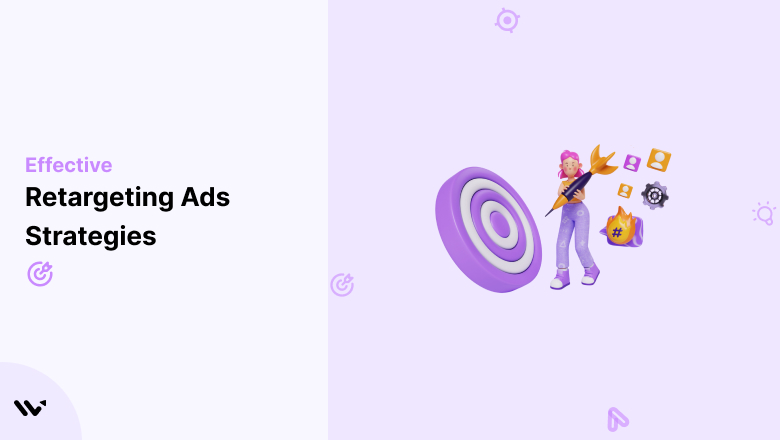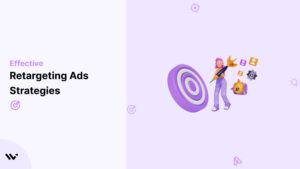One of the biggest challenges in eCommerce today is converting visitors who show interest but leave without completing a purchase.
Retargeting ads offer a powerful solution to re-engage these potential customers.
It helps businesses reconnect with potential customers who have interacted with their brand but haven’t converted.
With targeted messaging across platforms like Google Ads and Facebook, retargeting reminds customers of what they left behind and encourages them to complete their purchases.
Since retargeted ads get 10x more clicks than standard display ads and 70% of customers are more likely to convert after seeing them, retargeting is essential for boosting sales and increasing brand visibility.
Here, discuss the most effective retargeting advertising strategies to re-engage your customers.
Let’s go!
Visitors leave your website without taking action?
They don’t trust your site or feel urgency to act. WiserNotify builds both, turning doubt into action & visitors into customers.
How Retargeting Ads Works?
Retargeting ads have advanced and are driven by AI, real-time analytics, and cross-platform engagement. Below is an overview of the retargeting process from the first visitor interaction to the final conversion.
Visitor Interaction & Behavioral Tracking
Users visiting your site might explore various pages or add items to their cart but leave without purchasing. Tools like Google Analytics or Facebook Pixel track these interactions, gathering data on user behavior, including page views and time spent on specific products.
Cookie Placement for Personalized Retargeting
A cookie is placed in the visitor’s browser, recording their preferences and browsing patterns. This data allows businesses to tailor their retargeting ads based on specific actions—whether they viewed a product multiple times or abandoned a cart.
Audience Segmentation & Custom Audiences
By analyzing the collected data, businesses can segment users based on behaviors, such as those who spent over 5 minutes on product pages but didn’t make a purchase. Platforms like Google Ads and Facebook Ads offer custom audience creation, allowing brands to craft highly targeted campaigns for each segment.
Personalized Ad Creation with AI
AI-driven tools like Facebook’s Dynamic Ads or Google’s Responsive Display Ads now personalize ad content for each audience. For example, users who abandoned their carts can see a product-specific ad, potentially offering a discount to encourage a purchase.
Cross-Platform Real-Time Bidding
Retargeting ads are displayed across multiple platforms—from websites and mobile apps to streaming services and even smart TVs. Real-time bidding (RTB) ensures ads are shown to the right audience at the right time, optimizing ad spend.
Frequency Caps & Sequential Ads
Frequency capping prevents users from seeing the same ad too often, avoiding ad fatigue. Meanwhile, sequential retargeting guides users through a series of ads—one ad might reintroduce a product, while the benefits of the next highlight and the final ad might offer a special deal.
Conversion & Post-Click Optimization
Once users click through a retargeting ad, they are directed to a conversion-optimized landing page. These pages are dynamically generated to match the user’s ad interaction, providing a seamless experience. After conversion, post-conversion retargeting encourages upsells and increases customer lifetime value (CLV).
Retargeting uses advanced tech and data to create personalized omnichannel ads that re-engage customers. You can get the most out of your conversions now that you know the steps.
Types of Retargeting Advertising
New technologies and strategies will drive conversions and customer engagement in retargeting advertising. Here are the most effective types of retargeting ads.
1. Site Retargeting
Site retargeting is the oldest and most popular form of ad targeting. It targets users who have visited your website and left without taking a desired action, like buying or filling out a form.
Effectiveness
- With AI and machine learning advancements, site retargeting ads can be super personalized. Ads are dynamically created based on the specific pages or products the user interacts with, making them more relevant and effective.
- Site retargeting is no longer limited to web ads. These ads can appear in various formats across multiple channels, including social media, mobile apps, and even connected TV (CTV), increasing the chances of re-engagement.
2. Search Retargeting
Search retargeting targets users based on the keywords they have searched in search engines.
Unlike site retargeting, which targets users who have visited your site, search retargeting targets users who have shown interest in your products or services through search queries but haven’t visited your site.
Effectiveness
- With better data analytics, search retargeting will be more effective than ever. Businesses can use AI-driven insights to identify the most relevant keywords that indicate high purchase intent and target users accordingly.
- Search retargeting now tracks users across devices, so ads are delivered consistently whether the user switches from desktop to mobile, making the strategy more robust.
3. Social Media Retargeting
Social media retargeting shows ads to users who have interacted with your brand on social media. Retargeting advertising is highly effective for online businesses to reconnect with potential customers who did not convert during their initial website visit.
Since users spend most of their time on social media, this retargeting type is powerful in maintaining engagement and driving conversions.
Effectiveness
- Social media platforms have improved their targeting algorithms, so you can target specific behaviors such as liking a post, clicking on a link, or watching a video. This will make retargeting ads more relevant.
- Social media retargeting now supports various rich media formats, including carousel ads, video ads, and interactive ads, which are more engaging and can lead to higher conversion rates.
4. Email Retargeting
Email retargeting is re-engaging users who have interacted with your email campaigns but haven’t taken a desired action, such as clicking through to your site or making a purchase.
Effectiveness
- Email retargeting in 2025 will be super sophisticated. You can segment users based on their behavior within the email. For example, users who click on a product link but don’t purchase can be shown ads for that product.
- Many platforms now offer seamless integration between email marketing and retargeting campaigns, allowing you to create unified, multi-channel marketing efforts that increase conversion.
5. Dynamic Retargeting
Dynamic retargeting is an advanced form of ad targeting that shows ads with the exact products or services users viewed on your site.
Effectiveness
- Dynamic retargeting in 2025 will be even more powerful, as you can personalize ads in real time based on the user’s latest behavior. Thus, the ads will always be relevant to their most recent behavior.
- With AI, dynamic retargeting can now suggest related or complementary products within the ad to increase upsells and cross-sells.
6. Video Retargeting
Video retargeting is a new trend in 2025, where businesses can re-engage users through video ads.
These ads are shown to users who have interacted with your site or social media content, using the power of video to grab their attention and convert.
Effectiveness
- Higher Engagement: Video ads have higher engagement rates than static ads. With the rise of short-form video content (TikTok, Instagram Reels), video retargeting will be necessary to grab user attention.
- Interactive Video Features: Video retargeting ads often have interactive features like clickable links, product showcases, and call-to-action buttons so users can take action after the ad.
Retargeting remains crucial for digital marketing. It enables businesses to re-engage potential customers with personalized ads, boosting online presence, conversions, and revenue through various retargeting methods, such as social, site, and email.
8 Best Retargeting Strategies That Work in 2025
Retargeting is still vital to any digital marketing strategy. It reconnects with people who have visited your website, ads, or content. However, in 2025, technology, data, and consumer behavior have evolved, and retargeting has become more precise and effective. Here are the top retargeting strategies to follow.
1. Omnichannel Retargeting
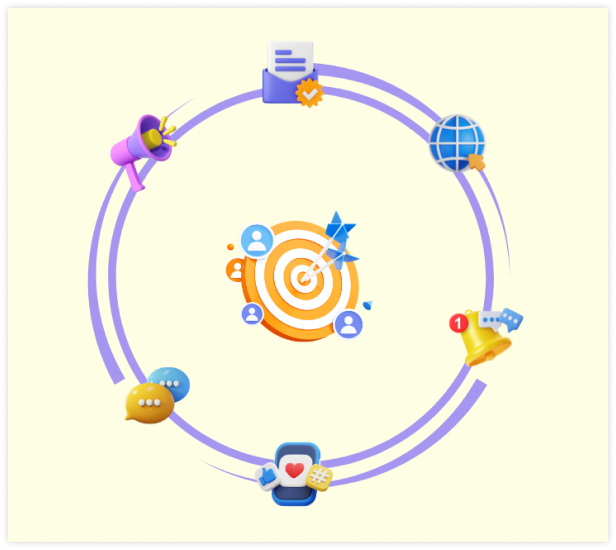
Omnichannel retargeting uses multiple platforms and devices to reach people wherever they are. This approach ensures consistent messaging across all touchpoints, including the website, social media, mobile apps, and offline channels like in-store visits.
- Omnichannel retargeting reinforces brand awareness and increases conversion by providing a consistent experience across all channels.
- With advanced tracking, brands can retarget users seamlessly across devices, so ads follow users from desktop to mobile.
Follow Tips
- Use a central customer data platform (CDP) to track and analyze user behavior across all channels.
- Tailor ads to the platform or device used (e.g., shorter, more visual ads on mobile).
2. Dynamic Retargeting with AI-Driven Personalization
Dynamic retargeting shows ads with products or content the user has interacted with. Nowadays, AI-driven personalization will take this to the next level by using machine learning algorithms to predict and show products that will convert.
- Dynamic retargeting increases click-through rates and conversions by showing users what interests them or might be interested in.
- AI-driven tools allow real-time ad content to be adjusted based on the user’s most recent interactions, keeping the ad relevant.
Use Tips
- Use AI-powered platforms that can analyze user behavior and automate the creation of personalized ads.
- Include upsell and cross-sell opportunities in dynamic ads by suggesting related products.
3. Sequential Retargeting
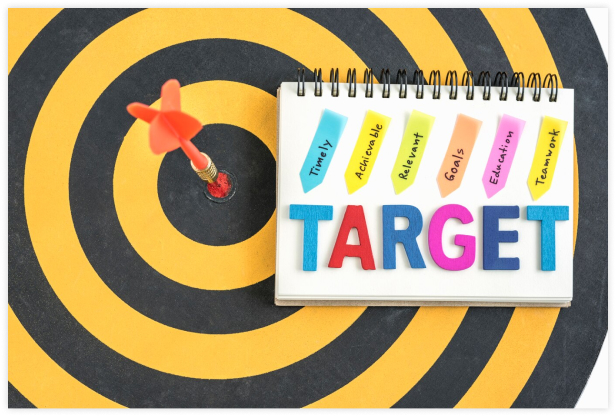
Sequential retargeting (ad sequencing) involves delivering ads in a specific order to guide the user through the conversion funnel. Each ad builds on the previous one to tell a story that leads to a final call to action.
- Sequential retargeting allows brands to tell a story that builds interest and trust over time and increases online sales.
- By controlling the sequence of ads, brands can address objections, provide more information, and offer incentives at the right time.
Implementation Tips
- Plan the ad sequence based on the user’s stage in the buying journey.
- Use A/B testing to refine the sequence and optimize for higher conversions.
4. Social Media Retargeting with Custom Audiences
Facebook, Instagram, and LinkedIn have advanced retargeting contextual targeting options through custom audiences. These audiences can be created based on user actions such as visiting your website, engaging with your social media content, or even opening your emails.
- Social media users are already in discovery mode and are more receptive to retargeting ads.
- Custom audiences allow super-precise targeting based on specific behavior, showing ads to the most relevant users.
Implementation Tips
- Use Facebook Pixel or similar tools to build custom audiences based on website behavior.
- Segment your audiences based on engagement levels and tailor your messaging accordingly.
5. Video Retargeting on High-Engagement Platforms
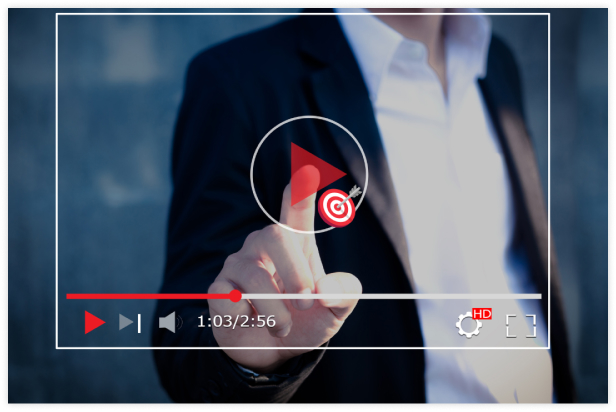
Video retargeting is becoming more popular, especially on platforms like YouTube, TikTok, and Instagram Reels. Video ads are more engaging and can grab the viewer’s attention, making them perfect for these retargeting marketing campaigns.
- Videos are more engaging than static images or text, making them more effective in grabbing attention and conveying a message.
- Users are more likely to remember video content, which can lead to higher brand recall and increased conversions.
Implementation Tips
- Create short, concise video ads that convey your message and include a clear call to action.
- Use platform-specific video formats and features like YouTube’s TrueView ads or Instagram’s Stories.
6. Email Retargeting with Automated Workflows
Email retargeting involves sending follow-up emails to users who have engaged with your emails but haven’t converted (e.g., purchased).
Automated workflows will make this process easier and more effective.
- Email is a direct line to the customer, so you can deliver personalized messages that prompt action.
- With automated workflows, you can send timely and relevant emails based on user behavior and increase the chances of conversion.
Follow Tips
- Set up automated email sequences triggered by specific actions like abandoned cart reminders or post-purchase follow-ups.
- Personalize the content of your emails based on the user’s previous interactions with your brand.
7. Geolocation-Based Retargeting

Geolocation-based retargeting targets users based on their physical location. This is perfect for businesses with physical stores, as you can deliver hyper-local ads encouraging in-store visits.
- Ads are more relevant when tailored to the user’s location, making them more likely to engage.
- Geolocation-based retargeting can drive foot traffic for brick-and-mortar businesses by offering localized promotions or incentives.
Follow Tips
- Use geofencing technology to target users within a specific radius of your physical location.
- Combine geolocation data with behavioral data to create highly targeted ads that resonate with local audiences.
8. Cross-Platform Retargeting with Unified ID Solutions
Cross-platform retargeting ensures users see the same message across all their devices and platforms. In 2025, unified ID solutions allow you to track users across different environments without third-party cookies.
- Cross-platform retargeting reinforces the brand message and increases conversion by delivering the same ads across multiple platforms.
- As third-party cookies disappear, unified ID solutions can maintain retargeting without compromising user privacy.
Implementation Tips
- Use unified ID solutions that allow for cross-device tracking and attribution.
- Make sure your ad creatives are platform and screen-size agnostic.
Using these techniques—you can re-engage with your potential customers, drive conversions, and get more ROI from your advertising campaigns.
How to Set Up a Successful Retargeting Campaign
Know Your Goals: Define your retargeting campaign’s goal. Whether it’s sales, brand awareness, or website traffic, a clear goal will guide your retargeting work strategy and measure success.
Segment Your Audience: Not all website visitors are the same, so segment your audience based on pages visited, time on site, or actions taken. This allows for more targeted and effective retargeting ads that speak to each group.
Choose the Right Ad: Select the format that fits your goals and target audience’s preferences. Options are display ads, video ads, social media ads, and dynamic ads that show products users have viewed.
Create Great Ad Creative: Design ads that grab attention and are relevant to your audience. Include a strong call-to-action (CTA) that tells users to take the next step, like returning to your website or purchasing.
Set Frequency Caps: To avoid overwhelming your audience, set frequency caps to limit how many times your ads are shown to the same user. This keeps the brand experience positive and prevents ad fatigue.
Track and Measure: Use analytics to monitor your campaign. Track CTR, conversion rates, and ROAS to see how they are performing and where to improve.
Measuring and Optimizing Your Retargeting Campaigns
Monitor the Metrics
Monitor CTR, conversion rate, and cost per acquisition (CPA). These metrics will tell you how your campaign performs and where to adjust.
A/B Testing
Continuously test different parts of your campaign, including ad creative, messaging, and targeting. A/B testing will tell you what resonates with your audience and drives more conversions.
Adjust Targeting and Segments
Review and refine your audience segments regularly to ensure your ads reach the most relevant users. Consider creating new segments based on updated user behavior data or expanding to similar target audiences.
Optimize Ad Frequency
Analyze the impact of ad frequency on engagement and conversion rates. Adjust your frequency caps to balance ad exposure with user experience so your ads stay effective without being intrusive.
Use Advanced Analytics
Use advanced analytics tools and platforms to gain deeper insights into user behavior and campaign performance. This will allow you to make data-driven decisions to improve your most successful retargeting campaigns.
Iterate and Refine
Retargeting is an ongoing process that requires continuous optimization. Refine your strategy based on performance data, industry trends, and changing consumer behavior to keep your campaign successful and efficient.
Conclusion
Implementing these cutting-edge strategies will increase customer retention and ensure your advertising budget is used efficiently, delivering measurable results and a better return on investment.
Retargeting is a powerful tool for businesses to reengage with potential customers and drive conversions. Advanced techniques like omnichannel retargeting, dynamic retargeting with AI, sequential retargeting, and more can help you create personalized and effective campaigns that resonate with your audience.
